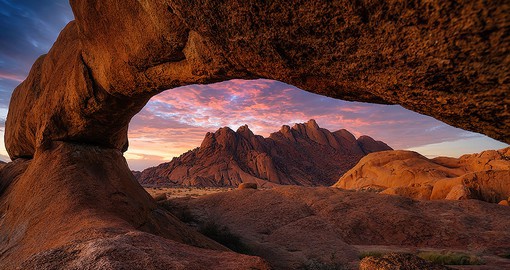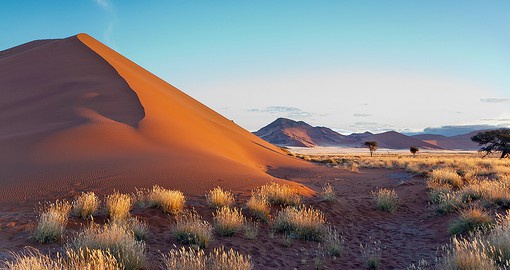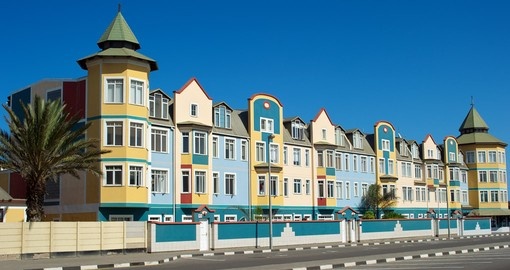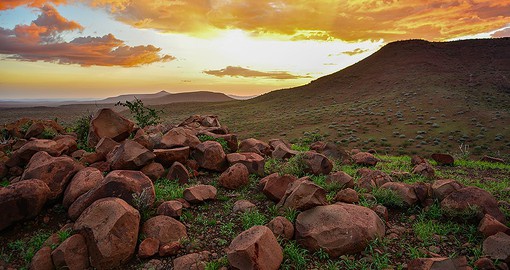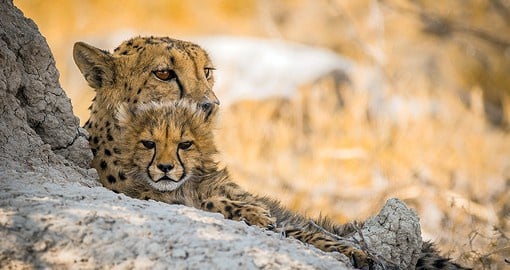Ultimate Namibia: Sossusvlei, Damaraland, Etosha & More
- Duration
- 10 Days
- Prices From:
- US$ 4,726
FIRST-CLASS | SMALL GROUP: This Ultimate Namibia safari affords you the chance to experience this magnificent country in a very personal way. You will have your own professional and experienced safari guide who will enhance your enjoyment of this unique country by ensuring a stress-free journey of discovery amid dramatic, ever-changing scenery.
This 10-day trip through Namibia uncovers one of Africa’s most awe-inspiring, yet enigmatic countries. Giant dunes, skeletal ghost towns, a native culture dating back thousands of years, and wildlife unlike anywhere else on the continent all form part of Namibia’s compelling puzzle.
Set out from Windhoek in your private safari vehicle, bound for the Sossus Dune Lodge in the most scenic part of the Namib Desert. Built with conservation in mind, the lodge is the ideal place to refresh from your flight, or if you have the energy, the ideal jumping-off point for a visit to Sesriem Canyon, or Elm Dune. Be sure to get some rest for the following day, when you visit Sossusvlei and Deadvlei, the otherworldly desert park where ghostly Acacia trees rise from the long dried marsh, all in the shadow of towering orange dunes. You can also pre-book (at extra cost) a hot air balloon flight for the early morning before you depart.
If Swakopmund seems like a small German beach resort, it’s with good reason. Namibia was once a German colony, and the architecture here preserves some of that past. As a result, it’s one of the most interesting seaside resorts you’ll ever visit. Swakopmund is as much a playground for nature lovers as it is history buffs. Journey out to Walvis Bay for kayaking in the outer lagoon. See fur seals, dolphins, flamingos, pelicans, and other wildlife that thrive in this largely unspoiled habitat.
Head into the mountainous region known as Damaraland, famous for its rock formations and pre-historic rock engravings. Hunter gatherers inhabited this land for thousands of years, leaving another fascinating piece of Namibia’s puzzle to explore. This is also another rich wildlife region. Keep your eyes peeled for elephants, rare black rhinos, and giraffes, all of whom call this desert landscape home. Adapted to this environment, some of Namibia’s animals differ to their counterparts in neighbouring South Africa or Botswana.
You’ll really start to notice this in Etosha National Park, probably Namibia’s most famous wildlife park. It’s also home to the native Himba people, and you’ll visit a local Himba settlement as part of your visit. After that, it’s time for game viewing in Etosha! There’s no telling exactly which animals you’ll see on any given day, but elephants, lions, giraffes, wildebeest, eland, kutu, zebra, oryx, rhinos, the world’s densest concentration of cheetahs…the list goes on. With so much to potentially see, you’ll have two days of game viewing here, staying at the beautiful Onguma Treetop Camp.
Your last day in Namibia takes you to the AfriCat Day Centre, which conducts valuable research and rehabilitation of injured or captured big cats including leopards and cheetahs. You’ll arrive back in Windhoek by late afternoon in time for a night flight, or stay an extra night if you’d rather not rush.
- Duration
- 10 Days
- Prices From:
- US$ 4,726
Itinerary View Trip Map
Windhoek to Sossusvlei Area
This morning your local representative will collect you from your Windhoek accommodation. You then depart Windhoek in your safari vehicle with your private guide and drive southwest through the scenic Khomas Hochland highlands before heading down the Great Escarpment into the Namib Desert below, stopping for a picnic lunch at a scenic location along the way.
You arrive at Dead Valley Lodge in the midafternoon and you will stay here for two nights whilst you explore the remarkable sights of the Namib Desert with your guide. If there is still time today, your guide will take you to visit Sesriem Canyon, a nearby geological attraction, or explore Elim Dune. However, if you prefer, you can just relax and soak in the scenic and tranquil surroundings at Dead Valley Lodge.
Sesriem Canyon: Sesriem Canyon has evolved through centuries of erosion by the Tsauchab River which has incised a narrow gorge about 1.5 km long and 30 meters deep into the surrounding conglomerates, exposing the varying layers of sedimentation deposited over millions of years. The shaded cool depths of the canyon allow pools of water to gather during the rainy season and remain for much of the year-round. These pools were a vital source of water for early settlers who drew water for their livestock by knotting six (ses) lengths of rawhide thongs (riems) together, hence the canyon and surrounding area became known as Sesriem.
Dead Valley Lodge: Dead Valley lodge opened in July 2019 and is situated inside the Namib Naukluft Park, in between the park gate at Sesriem and Elim Dune. It is therefore next to the road leading down to the world-famous Sossusvlei Dunes and "Deadvlei". The lodge offers 20 free-standing, climate-controlled luxury tented chalets, each with an adjoining bathroom and a panoramic view of the Namib Desert with towering red sand dunes, rugged mountain ranges and arid desert savannahs. The lodge restaurant serves delicious Namibian style meals, and guests can also relax in the picturesque bar by the swimming pool while looking out over the local desert scenery towards Elim Dune.
| Meal Plan | Lunch and Dinner |
|---|---|
| Duration | 2 Nights |
| Accommodation |
Dead Valley Lodge |
| Location | View map |
-
Dead Valley Lodge
The Dead Valley Lodge is situated inside the Namib - Naukluft Park, in-between Seriem and Elim Dune on the D826 road leading to the world-famous Dead Valley at Sossusvlei. The lodge offers twenty (20) free standing climate-controlled luxury tented chalets each with a panoramic view …
The Dead Valley Lodge is situated inside the Namib - Naukluft Park, in-between Seriem and Elim Dune on the D826 road leading to the world-famous Dead Valley at Sossusvlei. The lodge offers twenty (20) free standing climate-controlled luxury tented chalets each with a panoramic view of the Namib Desert with towering red sand dunes, rugged mountain ranges, and arid desert savannahs. The restaurant serves delicious Namibian - style cuisine whilst guest can relax in the picturesque bar with a swimming pool overlooking the Elim Dune. Games drives are offered in the mornings and afternoons to Sossusvlei and Sesriem Canyons.The Dead Valley lodge is situated inside the Namib -- Naukluft Park, in-between Seriem and Elim Dune on the D826 road leading to the world-famous Dead Valley at Sossusvlei. The lodge offers twenty (20) free standing climate-controlled luxury tented chalets each with a panoramic view of the Namib Desert with towering red sand dunes, rugged mountain ranges, and arid desert savannahs. The restaurant serves delicious Namibian - style cuisine whilst guest can relax in the picturesque bar with a swimming pool overlooking the Elim Dune. Games drives are offered in the mornings and afternoons to Sossusvlei and Sesriem Canyons.
Facilities
- Bar
- Restaurant
- Swimming Pool
Photo gallery
Photo 1 of 1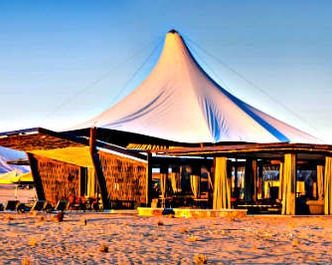
Sossusvlei / Namib Desert
This morning you will need to rise early for a magical excursion with your guide in the Namib Naukluft National Park, normally setting off before sunrise to capture the dunes whilst the light is soft and shadows accentuate the towering shapes and curves. This area boasts some of the highest free-standing sand dunes in the world and your guide will give you an insight on the formation of the Namib Desert and its myriad of fascinating creatures and plants that have adapted to survive these harsh environs. Once you have explored Sossusvlei, Deadvlei and surrounding dune fields to your heart's content you can enjoy a relaxed picnic brunch in the shade of a camel thorn tree. You then return to Dead Valley Lodge in the early afternoon in time for a late lunch, with the option to visit Sesriem Canyon afterwards if you haven't already done so the day before. The rest of the afternoon is at your leisure (from experience, this is usually welcomed after an exhilarating morning in the dunes).
Sossusvlei: This most frequently visited section of the massive 50,000 square km Namib Naukluft National Park has become known as Sossusvlei, famous for its towering apricot coloured sand dunes which can be reached by following the Tsauchab River valley. Sossusvlei itself is actually a clay pan set amidst these star shaped dunes which stand up to 300 meters above the surrounding plains, ranking them among the tallest dunes on earth. The deathly white clay pan contrasts against the orange sands and forms the endpoint of the ephemeral Tsauchab River, within the interior of the Great Sand Sea. The river course rises south of the Naukluft Mountains in the Great Escarpment. It penetrates the sand sea for some 55 km before it finally peters out at Sossusvlei, about the same distance from the Atlantic Ocean. Until the encroaching dunes blocked its course around 60,000 years ago, the Tsauchab River once reached the sea; as ephemeral rivers still do in the northern half of the Namib.
Sand-locked pans to the west show where the river previously flowed to before dunes shifted its endpoint to where it currently gathers at Sossusvlei. Roughly once a decade rainfall over the catchment area is sufficient to bring the river down in flood and fill the pan. On such occasions the mirror images of dunes and camel thorn trees around the pan are reflected in the water. Sossusvlei is the biggest of four pans in the vicinity. Another, famous for its gnarled and ghostly camel thorn trees, is Deadvlei which can be reached on foot over 1 km of sand. Deadvlei's striking camel thorn trees, dead for want of water, still stand erect as they once grew. They survived until about 900 years ago when the sand sea finally blocked the river from occasionally flooding the pan.
| Meal Plan | Breakfast, Lunch and Dinner |
|---|
Sossusvlei to Swakopmund
NOTE: Option to include a sunrise balloon flight or scenic light aircraft flight over the Namib Naukluft National Park before you depart for Swakopmund (optional extra at additional cost). Please note that if making use of this offer, it will need to be booked exclusively with Goway in order to fit in with other timings for this day.
The fascinating drive today takes you northwest through awesome and ever changing desert landscapes of the Namib Naukluft National Park, including the impressive Gaub and Kuiseb canyons. You will meet the coast at the port town of Walvis Bay and then continue north to Swakopmund where you can enjoy the pleasant seaside location and cooler coastal air for your next two nights. There will be time this afternoon to explore the town and wander along the waterfront on foot, before heading off for dinner at a popular restaurant which specializes in fresh seafood.
Swakopmund: Swakopmund resembles a small, German coastal resort nestled between the desert and the sea. It boasts a charming combination of German colonial architecture blended with modern hotels, shops, restaurants, museums, craft centres, galleries and cafés. Swakopmund had its beginnings as a landing station in 1892 when the German Imperial Navy erected beacons on the site. Settlers followed and made attempts to create a harbour town by constructing a concrete Mole and then an iron jetty - which attempts were ultimately unsuccessful. The advent of World War one halted developments, and the town sank into decline until half a century later when infrastructure improved and an asphalt road opened between Windhoek and Swakopmund. This made reaching the previously isolated town quicker and easier and it prospered once again to become Namibia's premier resort town. Although the sea is normally cold for swimming there are pleasant beaches and the cooler climate is refreshing after time spent in the desert.
The Delight Hotel Swakopmund: Amongst the town's captivating contrasts and old traditions, Gondwana's Delight is a fresh breeze in the desert. Conveniently located within short walking distance of the 'Mole', this modern, uplifting and inviting hotel is the ideal base for one's stay. Every effort is made to surprise and delight guests with thoughtful touches and locally inspired reasons to smile. Each en-suite room is designed with comfort in mind and is equipped with air-conditioning, tea/coffee station, fridge, TV, complimentary WiFi and safe.
| Meal Plan | Breakfast, Lunch and Dinner |
|---|---|
| Duration | 2 Nights |
| Accommodation |
The Delight |
| Location | View map |
-
The Delight
Amongst the town's captivating contrasts and old traditions, Gondwana's Delight is a fresh breeze in the desert. Conveniently located within short walking distance of the 'Mole', this modern, uplifting and inviting hotel is the ideal base for your stay. Every effort is made to surprise …
Amongst the town's captivating contrasts and old traditions, Gondwana's Delight is a fresh breeze in the desert. Conveniently located within short walking distance of the 'Mole', this modern, uplifting and inviting hotel is the ideal base for your stay. Every effort is made to surprise and delight guests with thoughtful touches and locally inspired reasons to smile.
Facilities
- Bar
- Free WiFi
- Garden
- Parking
- Restaurant
- Security
Photo gallery
Photo 1 of 1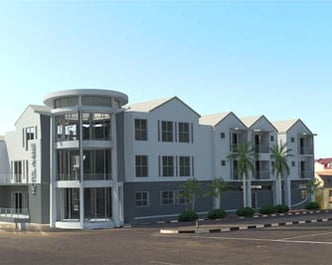

Swakopmund
After an early breakfast your guide will drive you along the scenic coastal road back south to Walvis Bay for a memorable kayaking adventure within the outer lagoon. After meeting your kayaking guide you will be taken on a short scenic drive to Pelican Point to see its lighthouse and windswept beauty, stopping briefly at the salt works to view the variety of birdlife on your way to the launch point. The kayaking is an ideal way of seeing Cape fur seals, Heaviside and bottlenose dolphins, pelicans, flamingos and a wide variety of other sea birds. If you are lucky, there is also a chance of seeing whales, leatherback turtles and sunfish. During the course of the day the guide will stop and inform you about the environment and light refreshments will be served on the beach before heading back to Walvis Bay.
Alternatively, you also have the choice to partake in a memorable motorized boat seal and dolphin excursion within the outer lagoon and harbour should the kayaking not appeal. Here you should also see Cape fur seals, heaviside and bottlenose dolphins, pelicans, flamingos and a wide variety of other sea birds. Again, if luck is on your side, there is also a chance of seeing whales, leatherback turtles and sunfish. During the course of the excursion snacks will be served along with local sparkling wine and fresh oysters, before you will return to the jetty at roughly midday.
You then have the opportunity to explore the waterfront area of Walvis Bay further before returning to Swakopmund for an afternoon at leisure at your guesthouse or out in town. Activities such as scenic flights, sandboarding and more can all be booked at an extra cost.
| Meal Plan | Breakfast, Lunch and Dinner |
|---|
Swakopmund to Damaraland
Continuing on your safari today, the road takes you north and east into the wonderful and diverse region of Damaraland. You pass Namibia's highest mountain, the Brandberg which peaks at 2,573 m above sea level, and take time to view game and absorb the vastness of the scenery along the way. Damaraland is typified by displays of colour, magnificent table topped mountains, rock formations and bizarre-looking vegetation. The present day landscape has been formed by the erosion of wind, water and geological forces which have formed rolling hills, dunes, gravel plains and ancient river terraces. It is the variety and loneliness of the area as well as the scenic splendour which will reward and astound you, giving one an authentic understanding of the word 'wilderness'. If time allows this afternoon your guide will take you to visit the nearby attractions and geological sites of the pre-historic Twyfelfontein rock engravings (a UNESCO World Heritage Site) - if not there is plenty of time to see them tomorrow.
Twyfelfontein: Strewn over a hillside amongst flat-topped mountains of red sandstone, Twyfelfontein's boulders and slabs of red sandstone hold some 2,500 prehistoric engravings that depict wildlife, animal spoor and abstract motifs. It is perhaps the largest and finest collection of petroglyphs in Africa. The engravings show animals such as elephant, giraffe, kudu, lion, rhinoceros, springbok, zebra and ostrich that once used to drink from a fountain at the bottom of the hill. In some cases footprints were engraved instead of hooves or paws. The abstract motifs feature mainly circles. Stone tools and other artifacts found at Twyfelfontein suggest that hunter-gatherers occupied the site over a period of perhaps 7,000 years. These days a local guide accompanies visitors to showcase the rock art. The engravings lie along two circular routes, one an hour's climb and the other 40 minutes longer. Twyfelfontein is one of Namibia's key National Monuments and is a UNESCO World Heritage Site.
Camp Kipwe: Camp Kipwe lies in the heart of Damaraland, ideally located a short drive from the local attractions in the area. The Camp is nestled amongst an outcrop of giant granite boulders, a stone's throw away from the ephemeral Aba Huab riverbed where desert adapted elephants often traverse. Each comfortable thatched bungalow is simply but tastefully furnished with en-suite open-air bathroom. In the centre of the camp lies a large al fresco dining area, bar, lounge and reception with an inviting fireplace nearby to relax beside in the evenings. A refreshing swimming pool and sunset lookout with lovely views also complement the Camp.
| Meal Plan | Breakfast, Lunch and Dinner |
|---|---|
| Duration | 2 Nights |
| Accommodation |
Camp Kipwe |
| Location | View map |
-
Camp Kipwe
Huddled in the rocks, with sweeping views across the Aba Huab valley, Camp Kipwe is full of surprises, starting when guests first arrive. It appears as if rocks have tumbled down the hill to reveal this gem of a camp. The setting is one of …
Huddled in the rocks, with sweeping views across the Aba Huab valley, Camp Kipwe is full of surprises, starting when guests first arrive. It appears as if rocks have tumbled down the hill to reveal this gem of a camp. The setting is one of intimacy and space. An inviting lounge area, where birds fly in to enjoy the water seeping from the rocks, a refreshing swimming pool nestled in the rocks and a scattering of bungalows complete this eco friendly camp. The surrounding space and endless views of Damaraland cannot be contained. They beckon you to explore - enjoy an early morning game drive in search of elusive desert dwelling elephants, hike in the ancient surroundings of the Aba Huab River or travel back in time at Twyfelfontein, Namibia's first World Heritage Site.
Facilities
- Bungalows
- Ensuite Bathrooms
- Free Parking
- Lounge
- Swimming Pool
Photo gallery
Photo 1 of 1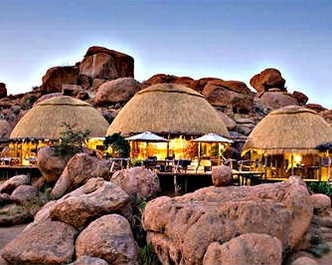
Damaraland
After an early breakfast you will be treated to an exciting 4x4 excursion along the ephemeral Aba Huab and Huab River valleys to explore this remarkable region and to search for game, including the elusive desert adapted elephants if they are in the area. Damaraland is home to a variety of desert adapted wildlife and hidden desert treasures. As the elephants are mostly active in the mornings you will normally have the best chance to see them then before returning to camp for lunch. However, if all the safari participants agree, you also have the option to take a picnic lunch and stop to enjoy that in the shade of a large Ana tree by the riverbed, ideally while watching a herd of elephant browsing nearby.
Your guide will arrange to fit in a visit to Twyfelfontein and other nearby attractions at a suitable time if you haven't already done so the previous day. On return to camp there should be time to take a walk into the local area with your guide if desired, or simply relax and enjoy some well-deserved leisure time.
Desert Adapted Elephant: In habitats with sufficient vegetation and water an adult elephant consumes as much as 300 kg of roughage and 230 litres of water every day of its life. Consider what a herd of them would eat and drink in a week or a month or a year. Finding an African elephant in a desert?
Well, yes and not only elephant, but other large mammals as well, such as black rhinoceros and giraffe. Their ranges extend from river catchments in northern Kaokoveld as far south as the northern Namib. Apart from the Kunene River, seven river courses northwards from the Ugab provide them with possible routes across the desert, right to the Skeleton Coast. The biggest are the Hoarusib, the Hoanib, the Huab and the Ugab Rivers. Desert adapted elephant in Kaokoland and the Namib walk further for water and fodder than any other elephant in Africa.
The distances between waterholes and feeding grounds can be as great as 68 km. The typical home range of a family herd is larger than 2,000 sq km, or eight times as big as ranges in central Africa where rainfall is much higher. They walk and feed at night and rest during the day. To meet their nutritional and bulk requirements they browse on no fewer than 74 of the 103 plant species that grow in their range. Not a separate species or even a subspecies, they are an ecotype unique to Namibia in Africa south of the equator, behaviourally adapted to hyper-arid conditions. Elephant in Mali on the southwestern fringe of the Sahara Desert are the only others known to survive in similar conditions.
| Meal Plan | Breakfast, Lunch and Dinner |
|---|
Damaraland to Southern Etosha National Park
Today you set off on your journey to the Ongava Game Reserve, which is situated on the southern border of Etosha National Park. You arrive in time for an afternoon game drive on the Ongava Game Reserve in an open game viewer with Ongava ranger, on shared basis with other lodge guests.
Ongava Game Reserve: The Ongava Game Reserve is effectively a private game reserve, spanning 30,000 hectares along the southwest border of Etosha National Park. The reserve is home to a wide variety of games including lion, leopard, giraffe, rhino, Hartmann's mountain zebra, gemsbok (oryx), kudu, steenbok and much more. The scenery is attractive with large open plains blending into Mopane tree woodlands and dolomite outcrops.
| Meal Plan | Breakfast, Lunch and Dinner |
|---|---|
| Duration | 1 Night |
| Accommodation |
Ongava Tented Camp |
| Location | View map |
-
Ongava Tented Camp
The 8 guest room Ongava Tented Camp is a small classic traditional tented camp. Guests sleep in "Meru" tents which are the classic East African style of tent. Each have double doors to allow for uninterrupted views of the bush and waterhole in front of …
The 8 guest room Ongava Tented Camp is a small classic traditional tented camp. Guests sleep in "Meru" tents which are the classic East African style of tent. Each have double doors to allow for uninterrupted views of the bush and waterhole in front of the camp and every tent has its own covered verandah. The tents have been tastefully furnished each with its own en-suite thatched bathroom with flush toilet and unique open air private shower. The bar and dining area is built out of rock and thatch and has an intimate feel. Drinks and dinner can be enjoyed around the open air fire place and swimming pool, both of which overlook a productive floodlit waterhole situated at eye level in front of the camp. The Ongava Tented Camp offers an alternative to the popular Ongava Lodge. It is a perfect location where one can a true in depth view or experience of life in the bush.
Facilities
- Bar(s)
- Fireplace
- Gift Shop
- Laundry/Dry Cleaning Service
- Library
- Lounge(s)
- Parking
- Pool (s)
Photo gallery
Photo 1 of 3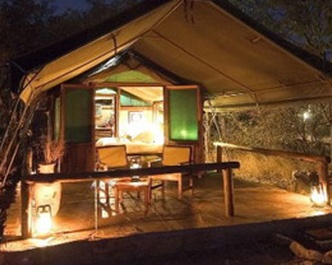
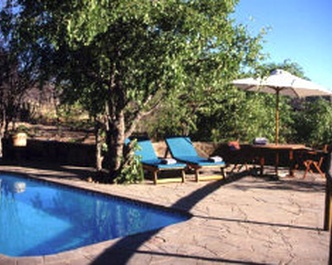
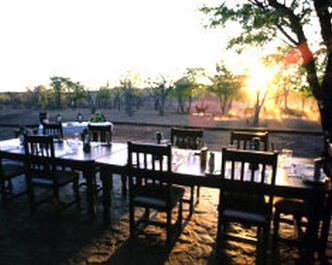
Southern Etosha National Park
Today you will be treated to an exciting morning guided game drive into the Etosha National Park, to see more of the wide variety of game and bird species that are to be found there. There is then time to relax by the refreshing swimming pool before you head out again for an afternoon game drive into Etosha before exiting the park before sunset.
Alternatively, you can opt to spend the whole day out in the park and either take lunch by one of the other rest camps in the area or have a picnic while watching a game at a particularly productive waterhole in the area. Once you are back (gates close at sunset), the rest of the evening can be spent game viewing at the camp's floodlit waterhole while enjoying dinner, and afterwards.
Etosha National Park: Etosha National Park covers 22,270 sq km, of which approximately 5,000 sq km is made up of saline depressions or 'pans'. The largest of these pans, the Etosha Pan, can be classified as a saline desert in its own right. The Etosha Pan lies in the Owambo Basin, on the north-western edge of the Namibian Kalahari Desert. Until three million years ago it formed part of huge, shallow lake that was reduced to a complex of salt pans when the major river that fed it, the Kunene, changed course and began to flow to the Atlantic instead. If the lake existed today, it would be the third largest in the world. Etosha is the largest of the pans at 4,760 k sq km in extent. It is nowadays filled with water only when sufficient rain falls to the north in Angola, inducing floods to flow southward along the Cuvelai drainage system. The Park consists of grassland, woodland and savannah. Game-viewing centers around the numerous springs and waterholes where several different species can often be seen at one time. The Park boasts some 114 mammal and over 340 bird species. Wildlife that one might see includes elephant, lion, giraffe, blue wildebeest, eland, kudu, gemsbok (oryx), zebra, rhino, cheetah, leopard, hyena, honey badger and warthog, as well as the endemic black faced impala.
| Meal Plan | Breakfast, Lunch and Dinner |
|---|---|
| Duration | 2 Nights |
| Accommodation |
Ongava Tented Camp |
| Location | View map |
-
Ongava Tented Camp
The 8 guest room Ongava Tented Camp is a small classic traditional tented camp. Guests sleep in "Meru" tents which are the classic East African style of tent. Each have double doors to allow for uninterrupted views of the bush and waterhole in front of …
The 8 guest room Ongava Tented Camp is a small classic traditional tented camp. Guests sleep in "Meru" tents which are the classic East African style of tent. Each have double doors to allow for uninterrupted views of the bush and waterhole in front of the camp and every tent has its own covered verandah. The tents have been tastefully furnished each with its own en-suite thatched bathroom with flush toilet and unique open air private shower. The bar and dining area is built out of rock and thatch and has an intimate feel. Drinks and dinner can be enjoyed around the open air fire place and swimming pool, both of which overlook a productive floodlit waterhole situated at eye level in front of the camp. The Ongava Tented Camp offers an alternative to the popular Ongava Lodge. It is a perfect location where one can a true in depth view or experience of life in the bush.
Facilities
- Bar(s)
- Fireplace
- Gift Shop
- Laundry/Dry Cleaning Service
- Library
- Lounge(s)
- Parking
- Pool (s)
Photo gallery
Photo 1 of 3


Southern Etosha National Park
Another morning dedicated to memorable game drives within the southern section of Etosha National Park with your guide. You return to camp for lunch and an early afternoon rest, spending your final afternoon on a game drive on the private Ongava Game Reserve. You then return after sunset with enough time to freshen up and enjoy your final 'safari dinner' overlooking the camp's floodlit waterhole.
| Meal Plan | Breakfast, Lunch and Dinner |
|---|
Ongava to Windhoek via the AfriCat Foundation
Your early departure will take you south from Ongava via Outjo and Otjiwarongo to reach Okonjima's AfriCat Day Centre, a wonderful highlight with which to conclude your safari. Okonjima is home to the AfriCat Foundation, a wildlife sanctuary which focuses on the research and rehabilitation of Africa's big cats, especially injured or captured leopard and cheetah. You arrive in time for lunch before embarking on an exciting and informative game drive and tour of the centre. Here you will learn about the function and vision of the AfriCat Foundation and will also get to meet some of the Foundation's special captive carnivore ambassadors.
PLEASE NOTE: There will be no tracking of wild cats on this visit and should that be required an overnight extension should be booked as per the below.
After the excursion and freshening up, the journey continues further south to arrive back in Windhoek in the late afternoon, just as the sun is setting. Upon your arrival in Windhoek you will be transferred to your accommodation establishment of choice, or out to the Windhoek International Airport (transfer to be booked additionally) if flying out in the evening - departure flights must be no earlier than 21h00 to allow sufficient time for the visit to the AfriCat Foundation and the journey back to Windhoek, or a final night in Windhoek can be arranged at additional cost if required. A final night in Windhoek is highly recommended!
| Meal Plan | Breakfast and Lunch |
|---|
Other Information
DEPARTURES:
Group Departures: Tuesdays
Private Touring: Daily
PRICE INCLUDES:
- Welcome pack
- 2 nights first-class accommodation in Sossusvlei
- 2 nights first-class accommodation in Swakopmund
- 2 nights deluxe accommodation in Damaraland
- 1 night moderate accommodation in Etosha National Park
- 2 nights in deluxe accommodation in Etosha National Park
- Transportation in a luxury air-conditioned safari vehicle (max 7 guests in vehicle)
- Shared services of a registered and experienced naturalist English-speaking safari guide (max 7 guests)
- Included shared sightseeing with entrance fees (max 7 guests):
- Visit to Sesriem Canyon
- Visit to Sossussvlei sand dunes and Deadvlei
- Kayaking or catamaran boat cruise in Swakopmund
- Visit to Twyfelfontein rock engravings
- 4x4 desert excursion
- 1 afternoon game drive in Etosha National Park in open game vehicle
- 1 morning game drive in Etosha National Park
- 1 full day game drive in Etosha National Park
- Afternoon game drive in Onguma Game Reserve
- Game drive in Okonjima Wildlife Sanctuary and tour of AfriCat Day Centre
- Mineral water on board the safari vehicle
- 9 breakfasts, 10 lunches, 9 dinners
PRICE EXCLUDES:
- Travel insurance
- International airfare & airfare taxes
- Meals and beverages not explicitly listed as included
- Gratuities
- Pre and Post extensions
- Arrival and departure airport transfers
- Optional excursions
- Items of a personal nature
- Visa fees if applicable
TERMS AND CONDITIONS:
Prices are "from" per person based on twin/double share accommodation and for travel in low season. Seasonal surcharges and blackout dates may apply. Limited seat/spaces and all pricing is subject to change and availability. Rates for single or triple travellers are available on request - please inquire.
5 Dec 2023






